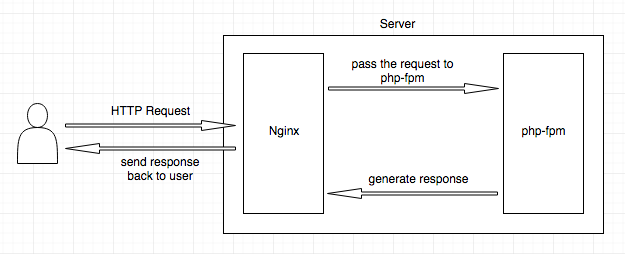Sidebar
Table of Contents
Nginx
NGINX is a free, open-source, high-performance HTTP server and reverse proxy, as well as an IMAP/POP3 proxy server. NGINX is known for its high performance, stability, rich feature set, simple configuration, and low resource consumption
the nginx configuration file can be found in: /etc/nginx/nginx.conf
This file consists of:
- directive: the option that consists of name and parameters; it should end with a semicolon
gzip on;
- context: the section where you can declare directives (similar to scope in programming languages)
worker_processes 2; # directive in global context http { # http context gzip on; # directive in http context server { # server context listen 80; # directive in server context } }
Processing requests
Inside nginx, you can specify multiple virtual servers, each described by a server { } context.
server { listen *:80 default_server; server_name netguru.co; return 200 "Hello from netguru.co"; } server { listen *:80; server_name foo.co; return 200 "Hello from foo.co"; } server { listen *:81; server_name bar.co; return 200 "Hello from bar.co"; }
Nginx will first check the listen directive to test which virtual server is listening on the given IP:port combination.
Then, the value from server_name directive is tested against the Host header, which stores the domain name of the server.
Nginx will choose the virtual server in the following order:
- Server listing on IP:port, with a matching
server_namedirective; - Server listing on IP:port, with the
default_serverflag; - Server listing on IP:port, first one defined;
- If there are no matches, refuse the connection.
server_name directive
server_name netguru.co www.netguru.co; # exact match server_name *.netguru.co; # wildcard matching server_name netguru.*; # wildcard matching server_name ~^[0-9]*\.netguru\.co$; # regexp matching
Gzip
Enabling gzip should significantly reduce the weight of your response, thus it will appear faster on the client side.
SSL and TLS
SSL (standing for Socket Secure Layer) is a protocol providing a secure connection over HTTP. Technically SSL and TLS are different (as each is describing the different version of a protocol) - but many use those names interchangeably.
Base SSL/TLS setup
server { listen 443 ssl default_server; listen [::]:443 ssl default_server; ssl_certificate /etc/nginx/ssl/netguru.crt; ssl_certificate_key /etc/nginx/ssl/netguru.key; }
Reverse proxy
A reverse proxy is an intermediary proxy service which takes a client request, passes it on to one or more servers, and subsequently delivers the server’s response to the client. Benefits:
- Load Balancing
- Increases security
- Easy loggin and auditing
https://medium.com/@mohsin061/forward-proxy-and-reverse-proxy-500b9bd4bf8e
PHP
PHP-FPM
location ~* \.php$ { fastcgi_pass unix:/run/php/php7.0-fpm.sock; }
#fastcgi_pass 127.0.0.1:9000; #tcp connection #fastcgi_pass unix:/tmp/php5-fpm.sock; #unix socket
Using a socket (e.g. listen = '/tmp/php-fpm.sock') makes sense when both the front-end (e.g. Nginx) and php-fpm are in the same box and
C10K problem is referred for the network socket unable to handle a large number of client (10,000) at the same time.


